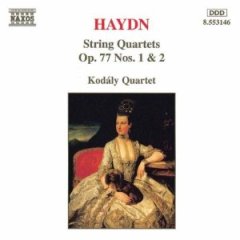Joseph Haydn - String Quartets Op.77 (1995)
Joseph Haydn - String Quartets Op.77 (1995)

Stringquartet in G major op.77 No.1 1. Allegro moderato 2. Adagio 3. Minuetto – Trio 4. Finale. Presto. Stringquartet in F major op.77 No.2 5. Allegro moderato 6. Menuetto. Presto ma non troppo – Trio 7. Andante 8. Finale. Vivace assai. Kodaly String Quartet
Haydn composed his opus 77 string quartets (there are only two) in 1799 and dedicated them to Prince Lobkowitz, who would also become a major patron of Beethoven. They are Haydn's last completed works in this form. Together with opus 76, the opus 77 works constitute the summit of Haydn's achievement in the string quartet. These two works are closely and intricately written with detailed part writing, counterpoint, and creative use of the sonata form. They manage to be both spacious and spare in structure. Yet for all their seriousness and craft, the opus 77 quartets are a delight to hear. Haydn had the extraordinary ability to be both accessible and deep. The quartets work at the level of the musical involvement of the listener. Put another way, Haydn had the ability to convey both cheerfulness and high seriousness in his music. This ability is at its height in these two quartets. Haydn scholar Karl Geringer observed in his study of the composer that these quartets were written "when true expression seemed more important to Haydn than a perfect balance between form and content." (Haydn: A Creative Life in Music at 323)
There are not many individual recordings of the opus 77 quartets. Thus it is doubly fortunate that they are available in an outstanding reading by the Kodaly Quartet as part of its cycle of the Haydn quartets and that the CD sells for a budget price on the Naxos label.
The first quartet in G major opens with an allegro moderato featuring a lilting first theme in the violin over a brushing accompaniment. The violin and the cello soon join in a dialogue over the theme. The exposition is expansive and lengthy but detailed at the same time. After a broad development section which moves widely among different keys, the exposition returns in a much-shortened recapitulation. The second movement is an adagio in a remote key from the opening movement. It features a singing theme given to the cello, and the meditative character of the movement is punctuated by several long pauses. The movement is serene, and it glows. The third movement is a minuet, which in both this quartet and the second quartet, is brusque and rapid almost in the manner of a Beethoven scherzo. This minuet features a gypsy-like theme. The finale is a rapid, lively presto with a great deal of counterpoint and interplay among the voices. The movement is througout based on the theme announced at its opening.
The second quartet of opus 77 is in F major and strikes me as more serene than its companion. The first movement, allegro moderato, begins with a single chord which is followed by a lyrical theme, and a slower-paced secondary theme. The movement develops tension during the development which ends in a minor key before returning to the opening material. The second movement of this quartet is the minuet which, again, is quick, rough and brusque. The contrasting trio is smoother in character and is placed in the lower part of the register of the instruments. The third movement, andante, is taken at a walking pace with a theme that grows in intensity as it proceeds. After a dramatic stop, the them is repeated in the cello accompanied by a lovely filigree in the violins. The finale, vivace assai, opens with a loud unison chord followed by a quirky, gay theme that is used throught the movement and subjected to contrapuntal treatment. It reaches a large climax, pauses, and rushes on to a light, joyful close.
Haydn was a masterful composer of string quartets and these, his final efforts, are among his greatest. They constitute pure music at its best and are full of the sheer joy and craft of music-making. Those listeners who would like to enhance their enjoyment of this music by reading a short but perceptive recent appreciation of Haydn may find rewarding Terry Teachout's article, "Haydn!" in the January, 2005 issue of "Commentary". --- Robin Friedman, amazon.com
download: uploaded anonfiles yandex 4shared solidfiles mediafire mega filecloudio nornar
Last Updated (Sunday, 29 December 2013 22:26)








